Round Rock, Texas, Hgh State Clinic, Hgh Injections, Hrt Doctors
Round Rock, Texas Blood Testing Facilities
 Represents a LabCorp blood testing facility
Represents a LabCorp blood testing facility Represents a Quest Diagnostics blood testing facility
Represents a Quest Diagnostics blood testing facility

Nearby Labcorp Blood Testing facilities:
- Labcorp Center Distance: 2 m, 16030 Park Valley Suite 200, Round Rock, Williamson County, TX, 78681
- Labcorp Center Distance: 14 m, 711 W 38Th St Suite B-2, Austin, Travis County, TX, 78705
- Labcorp Center Distance: 20 m, 4207 James Casey St Ste 101, Austin, Travis County, TX, 78745
- Labcorp Center Distance: 59 m, 2115 Stephen's Place 1200, New Braunfels, Comal County, TX, 78130
- Labcorp Center Distance: 73 m, 2410 Wycon Drive Suite 104, Waco, McLennan County, TX, 76712
- Labcorp Center Distance: 77 m, 12602 Toepperwein Rd Ste 220, Live Oak, Bexar County, TX, 78233
- Labcorp Center Distance: 78 m, 19016 Stone Oak Parkway 265, San Antonio, Bexar County, TX, 78258
- Labcorp Center Distance: 80 m, 124 E Bandera Rd Ste 303, Boerne, Kendall County, TX, 78006
- Labcorp Center Distance: 81 m, 8601 Village Dr Ste 202, San Antonio, Bexar County, TX, 78217
- Labcorp Center Distance: 82 m, 1602 Rock Prairie Rd Ste 260, College Station, Brazos County, TX, 77845
- Labcorp Center Distance: 87 m, 5282 Medical Dr Ste 190, San Antonio, Bexar County, TX, 78229
- Labcorp Center Distance: 88 m, 1303 Mccullough Ave Ste 429, San Antonio, Bexar County, TX, 78212
- Labcorp Center Distance: 89 m, 343 W Houston St Ste 308, San Antonio, Bexar County, TX, 78205
- Labcorp Center Distance: 92 m, 3103 S.E. Military Dr Ste 104, San Antonio, Bexar County, TX, 78223
- Labcorp Center Distance: 93 m, 3903 Wiseman Blvd Suite 219, San Antonio, Bexar County, TX, 78251
- Labcorp Center Distance: 95 m, 7390 Barlite Blvd Ste 135, San Antonio, Bexar County, TX, 78224
Nearby Quest Blood Testing facilities:
- Quest Center Distance: 11 m, 651 N. Us Hwy 183, Leander, Williamson County, TX, 78641-7001
- Quest Center Distance: 14 m, 3708 Jefferson Street, Austin, Travis County, TX, 78731-6206
- Quest Center Distance: 20 m, 2301 Ranch Rd 620 South, Lakeway, Travis County, TX, 78734-6240
- Quest Center Distance: 42 m, 2300 S Clear Creek Rd, Killeen, Bell County, TX, 76549-4984
- Quest Center Distance: 65 m, 305 Singing Oaks, Spring Branch, Comal County, TX, 78070-6505
- Quest Center Distance: 75 m, 7125 Sanger Avenue, Waco, McLennan County, TX, 76712-3981
- Quest Center Distance: 77 m, 18707 Hardy Oak Blvd, San Antonio, Bexar County, TX, 78258-4891
- Quest Center Distance: 88 m, 1303 Mccullough Ave, San Antonio, Bexar County, TX, 78212-5628
- Quest Center Distance: 89 m, 6100 Bandera Road, San Antonio, Bexar County, TX, 78238-1666
Texas Hormone Replacement Therapy Services
Are you interested in Hormone Replacement Therapy Solutions, but don't know where to turn? The Conscious Evolution Institute is your best source for quality Physician-Monitored Bio-Identical Hormone Therapy Services in the United States. We provide fast and effective service to get you the exact Hormone Treatments that you need to balance your health and improve your well-being!
Bio-Identical HGH Injections in Texas
Human Growth Hormone Deficiency is a significant medical condition which can severely restrict your ability to live a long and happy life. If you are over the age of thirty and are suffering from symptoms such as fatigue, poor sleep, depression, and unexplained changes in body composition, you may be a candidate for Bio-Identical HGH Injections.
These injections restore normal and optimal Hormone Balance for patients suffering from Age-Related Growth Hormone Deficiency, potentially allowing them to live longer and healthier lives.
Sermorelin Therapy in Texas
The Conscious Evolution Institute also offers Sermorelin Injections as an alternative to Human Growth Hormone. Sermorelin Acetate is able to restore normal HGH levels by stimulating the pituitary gland, and both forms of treatment have their own particular advantages and disadvantages, but both forms of treatment are incredibly safe.
Low Testosterone Treatments in Texas
If you are suffering from erectile dysfunction or other sexual woes as you grow older, you may be suffering from Low-T. Both Low-T and HGH Deficiency share many symptoms and characteristics, but Low-T has a more significant impact on sexual health.
Bio-Identical Testosterone Replacement Therapy comes in many forms: Cream, Patch, Injections, and even dermal implant, and all of these methods have been proven highly effective at restoring normal Testosterone concentrations in the blood stream. Women can even benefit from the Testosterone Replacement, particularly women that are suffering from symptoms related to sexual dysfunction.
HCG Injections in Texas
Are you overweight or obese? Have you tried everything to lose the weight but have been unable to stick with an effective diet? HCG Therapy may be the perfect choice for you. HCG Injections, combined with caloric restriction, have been clinically shown to encourage weight loss safely and quickly.
HCG encourages your body to burn adipose fat over muscle tissue, and also inhibits the psychological impact of hormones such as Ghrelin, which directly stimulate the feeling of hunger in your mind. HCG Shots prevent the feelings of fatigue associated with caloric restriction, allowing you to live your day-to-day life like normal, while encouraging your body to quickly shed excess bodyfat.
Largest Metro Populations in Texas
Dallas
Dallas-Fort Worth is the largest metropolitan area in the state of Texas, and Dallas is one of the most important economic powerhouses of the United States. Behind Chicago, Los Angeles, and New York City, the area employs more people than any other place in the United States. Dallas also has a large number of Fortune 500 companies.
The Dallas metro is unique, because it is the largest metropolitan city without any form of sea access, which has necessitated it to have a large and broad transportation system based on rail, trucking, and air traffic. Dallas is the home of the MLB Texas Rangers, NBA Mavericks, and NFL Cowboys.
Houston
Houston is the largest city in the state of Texas, and represents the second largest metropolitan population. Like Dallas, Houston is another city with a huge business presence, and is home to more Fortune 500 companies than any other city in the United States besides New York City.
The Port of Houston is one of the most important transportation ports in the United States, second only to the ports of New Orleans in terms of the amount of cargo transported in and out of the United States every year. Houston is home to the NBA Rockets, MLB Astros, and NFL Texans. Galveston also belongs to the Houston Metropolitan area and offers beautiful beaches and contributes to the high tourist value of the area.
San Antonio
San Antonio is the third largest metro area in Texas and the fastest growing area of the state of Texas. San Antonio is much different than Houston or Dallas, because the vast majority of the metro population live within the city limits of San Antonio, with very few people located outside of the city.
The city of San Antonio has a large population of military residents, and is the home of a number of military bases, including Randolph Air Force Base, Lackland Air Force Base, and Fort Sam Houston. The city is home to one major professional sports team: the San Antonio Spurs.
Austin
Austin, Texas, is the fourth largest metro area in Texas and is the capital of the state. The city is widely known as one of the most important cultural centers in Texas, and perhaps even the United States. Austin is most well known for the South by Southwest festival (SXSW), which is a city-wide music festival which hosts many of the most interesting and unique musical acts in the country, in addition to showcasing other forms of art, such as film.
El Paso
El Paso is the fifth largest metro area in Texas, and is located on the far-western tip of the state. The city is located on the border of the United States with Mexico, and is contiguous with Juarez on the other side of the border. El Paso is unique in the United States and even the Western Hemisphere because of its huge bilingual workforce which includes individuals from two countries.
Like San Antonio, El Paso has a large military population. El Paso is home to Fort Bliss and Biggs Army Airfield. Fort Bliss is the largest military training facility in the United States.
All About Round Rock, Texas Geographic Area

Round Rock is a city in Travis and Williamson counties in the U.S. state of Texas. It is part of the Austin aeRound Rock aeSan Marcos metropolitan area. The 2010 census places the population at 99,887.
The city straddles both sides of the Balcones Escarpment, a fault line in which the areas roughly east of IH-35 are flat and characterized by having black, fertile soils of the Blackland Prairie, and the west side of the Escarpment which consists mostly of hilly, karst-like terrain with little topsoil and higher elevations and which is part of the Texas Hill Country. Located about 20 miles (32 km) north of downtown Austin, Round Rock shares a common border with Austin at SH 45.
In August 2008, Money magazine named Round Rock as the seventh-best American small city in which to live. Round Rock was the only Texas city to make the Top 10. In a CNN article dated July 1, 2009, Round Rock was listed as the second-fastest growing city in the country, with a population growth of 8.2% in the preceding year.
Round Rock has a strong public education system. According to the 2008 ratings from the Texas Education Agency, the Round Rock Independent School District (RRISD) ranks among the best in the state. Of 42 schools within it, twelve were rated exemplary and eleven are recognized. No RRISD school received an academically unacceptable rating.
Round Rock is perhaps best known as the international headquarters of Dell, which employs approximately 16,000 people at its Round Rock facilities. The presence of Dell along with other major employers, a strong economic development program, favorable tax rates, and major retailers such as IKEA and a Premium Outlet Mall, and the mixed use La Frontera center, have changed Round Rock from a sleepy bedroom community into its own self-contained "super suburb."
Round Rock and Williamson County have been the site of human habitation since at least 9,200 BC. The earliest known inhabitants of the area lived during the late Pleistocene (Ice Age), and are linked to the Clovis culture around 9,200 BC (11,200 years old) based on evidence found at the much-studied Gault Site, midway between Georgetown and Fort Hood. One of the most important discoveries in recent times is that of the ancient skeletal remains dubbed "The Leanderthal Lady" because of its age and proximity to Leander, Texas. The site is 4 miles (6 km) west of Round Rock and was discovered by accident by Texas Department of Transportation workers while drilling core samples for a new highway. The site has been extensively studied for many years and samples carbon date to this particular Pleistocene period at approximately 10,500 years ago (8,500 BC). Prehistoric and Archaic Period "open occupation" campsites are also found throughout the county along streams and other water sources including Brushy Creek in Round Rock and the San Gabriel River in Georgetown, ten miles (16 km) north. These archeology dig sites show a much greater volume of evidence of Archaic Period inhabitants based on relics and flint tools recovered from burned rock middens. The earliest known "historical" Native American occupants, the Tonkawa, were a flint-working, hunting people who followed the buffalo on foot and periodically set fire to the prairie to aid them in their hunts. During the 18th century they made the transition to a horse culture and used firearms to a limited extent. There also appear to have been small numbers of Kiowa, Yojuane, Tawakoni, and Mayeye Native-Americans living in the county at the time of the earliest Anglo settlements. After they were crowded out by white settlement, the Comanches continued to raid settlements in the county until the 1860s. In the late 19th century, Native Americans were being push out of Central Texas.
As the area developed into a rural Anglo community, some of the new paved roads actually followed the original Native-American pathways. One famous immigration route passed through Round Rock and is called the "Double File Trail" because the path was wide enough for two horsemen to ride side-by-side. It is part of a longer trail from north Texas that crossed the San Gabriel River in Georgetown, Brushy Creek in Round Rock, and the Colorado River in Austin. An elementary school in the Round Rock school district is named for the trail, Double File Trail Elementary School.
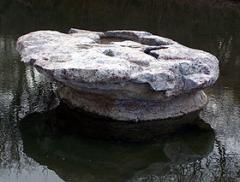
In 1851, a small community was formed on the banks of Brushy Creek, near a large round and anvil-shaped rock located in the middle of the creek. This round rock marked a convenient low-water crossing for wagons, horses, and cattle. The first postmaster called the community "Brushy," and the creek was called "Brushy Creek". But in 1854, at the suggestion of the postmaster, the small settlement was renamed Round Rock in honor of this now famous rock. After the Civil War, Jesse Chisholm began moving cattle from South Texas through Round Rock on the way to Abilene, Kansas. The route he established, which crossed Brushy Creek at the round rock, became known as the Chisholm Trail. Most of the old buildings, including the old Saint Charles Hotel, have been preserved. This historic area is now called "Old Town."
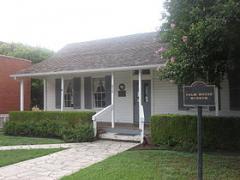
Downtown Round Rock was the site of an historic gunfight and subsequent capture (and death) of the 19th-century American train robber Sam Bass, by the Texas Ranger Division on July 19, 1878. The Rangers followed Bass and his gang after they robbed the Fort Worth-to-Cleburn train. Bass was tracked to Round Rock and as he attempted to flee, Bass was shot and killed in a gun battle by Ranger George Herold and Ranger sergeant Richard Ware. Near Ware was Soapy Smith, a noted con man, and his cousin Edwin, who witnessed Ware's shot. Soapy exclaimed, "I think you got him." The event is known locally as the "Sam Bass Shootout." This shootout is re-created each year at the July 4 'Frontier Days' Celebration in Old Settlers Park. Bass is buried in Round Rock Cemetery, located northwest of "Old Town" on Sam Bass Road. His original headstone can be found on display at the Round Rock Public Library.

In the first half of the 20th century the county's wealth came from the cotton fields. Cotton, row-crops, grapes, and truck farming were the predominat subsistence east of Interstate 35. West of the Balcones divide ranchers raised cattle, sheep and to a lesser extent goats. Due to Round Rock's favorable geographic location over the rich, fertile "blackland prairie" soils also known locally as the "black waxy" (due to the soil's high clay content), cotton was the largest economic driver at that time. Because of the soil and climate, this eco-region is ideally suited to crop agriculture. Nearby Taylor, Texas, east of Round Rock, was the primary cotton center where the crop was hauled for ginning (its seeds mechanically removed) at the cotton gin, compressed into bales, and shipped by train. Austin was also a cotton center for a time once the railroad arrived there in the 1870s. Cotton production and cattle raising, on a much smaller scale, continues today although primarily east of Round Rock.
To preserve the heritage of the famous crossing, a Chisholm Trail Crossing Park was developed to provide visitors with a simulated scene of Round Rock's historical role in the Chisholm cattle drive. Commemorative plaques in the park tell of the history of Round Rock. The bronze sculptures of four steers and pioneer woman Hattie Cluck and her son, Emmitt, were commissioned by the City through donations from Round Rock residents. The sculptures depict Round Rock's history as a crossing location along the Chisholm Trail.[clarification needed] The project plans include 18 to 20 additional bronze statues over time.
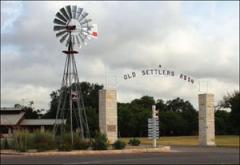
Following the end of the American Civil War a group of Confederate veterans held a reunion in Georgetown on August 27, 1904, for the old settlers of Williamson County and their descendants. The invitation promised "good music, plenty to eat, and above all a warm welcome." The event was well-attended, and reunions ae now called Old Settlers Association (OSA) reunions ae have been held annually ever since. After the initial one, the event was moved to Round Rock and eventually a structure was built (along with three restored log cabins) in the Palm Valley area of Round Rock, in front of Old Settlers Park, just off Highway 79 in east Round Rock. All members of the organization are descendants of Williamson County residents prior to 1904. OSA has approximately 50 active members and 300 members total. The Old Settlers Association today is a social and educational group, with the purpose of facilitating social activities, as well as collecting and preserving important historical information and facts. The facilities are rented for meetings, arts and craft and collectable shows, events, parties, weddings and rehearsal dinners.
In the 1950s, Taylor was the economic powerhouse in the county due to it being the center of cotton production and shipping and had a large population. So it was expected, then, that the proposed Interstate 35, part of the new Interstate Highway System would pass through Taylor on its way from Dallas to Austin. In fact, the original routing plans drawn by Highway Commioner DeWitt Greer called for the "interregional" highway to go through Taylor. Some of the citizens and leadership of Taylor lobbied against the Taylor route citing multiple concerns ranging from the loss of farmland, to unwanted right of way (ROW) acquisition ae it was proposed to be an astounding 300 feet (90 m) wide, unheard of before this time aethe possibility of cutting farmers off from their fields or having their fields be located on opposite sides of the road, traffic noise, and loss of country life. No one even knew what an "Interregional Highway" would look like. Instead they wanted improvements to the farm-to-market roads and a straight route to Austin.

Meanwhile, Round Rock leaders wanted the highway to come their way as they were focused on the potential economic development opportunities it would bring. At that time no one had ever seen such a road as an "Interstate" (unless they had traveled to Germany to see the Autobahn or Connecticut), but then-Mayor Louis Henna lobbied hard at the Highway Commission for the Round Rock route. In June 1956, the fifteen-year debate over the form, funding and route of the Interstate was resolved. Due to the heavy lobbying effort, and not wanting to antagonize Taylor, the route was eventually changed and the highway was built along the edge of the Balcones Fault line running through Round Rock. The precise route was not without opposition, however, as the final route cut off "Old Town" to the west from what had become the more recent "downtown" area east of Interstate 35. The Interstate eventually made Round Rock into a viable and vibrant commercial center. Due to the Interstate and the reduction in the importance of cotton as a primary crop, Taylor is today a minor, modest town with a smaller population, while Round Rock has thrived and rapidly grown into the largest city in the county, attracting companies like Dell Computer and major retail centers. The transformation of Round Rock is detailed in a book by Linda Scarborough (publisher of the Williamson County Sun newspaper) titled Road, River and Ol' Boy Politics: A Texas County's Path from Farm to Supersuburb published by Texas State Historical Press.
By the 1990s, Round Rock was primarily a bedroom community with the majority of its employed residents working in Austin and then returning home after work to places like Round Rock and Georgetown where housing and land was less expensive. In the 1990s, Round Rock had few major employers and jobs other than local retail and other services, or ranching and farming. But in the late 1990s, that began to change as economic development became a major focus of the City and the Chamber of Commerce. Dell Corp (later renamed Dell) moved its headquarters to Round Rock and provided significant jobs with 16,000 employees, at its Round Rock headquarters, as well as other major employers allowing many residents to work in the community where they live. (See also the Business and economic development section in this article.)
Round Rock is located 17 miles (27 km) north of Austin, and 10 miles (16 km) south of Georgetown. Its elevation is 709 ft (216 m).
According to the US Census Bureau, the city has a total area of 26.3 square miles (68.0 km2), of which 26.1 square miles (67.7 km2) are land and 0.1 square mile (0.3 km2) (0.50%) is water.
As of the 2009 U.S Census Bureau, there were 94,777 people and 94,272 households, residing in the city. There were 33,089 housing units with 20,364 owner-occupied homes costing at a median value of $163,400. The racial makeup of the city was 76.4% White, 9.4% African American, 0.4% Native American, 4.1% Asian, 0% Pacific Islander, 5.7% from other races, and 3% from two or more races. Hispanic or Latino of any race made up 25% of its population. According to a 2009 estimate by the U.S Census Bureau, the median income for a household was $69,892, and the median income for a family was $79,417.
There were 21,076 households out of which 47.5% had children under the age of 18 living with them, 60.5% were married couples living together, 11.0% had a female householder with no husband present, and 24.4% were non-families. 18.1% of all households were made up of individuals and 3.0% had someone living alone who was 65 years of age or older. The average household size was 2.87 and the average family size was 3.29.
In the city the age distribution of the population shows 31.9% under the age of 18, 8.5% from 18 to 24, 38.8% from 25 to 44, 16.3% from 45 to 64, and 4.5% who were 65 years of age or older. The median age was 30 years. For every 100 females there were 99.1 males. For every 100 women age 18 and over, there were 96.3 men.
The city of Round Rock is managed through a council-manager form of government. The City Council is composed of six city council members and the mayor. The mayor and all council members are elected at large and serve the entire city, not by geographic precincts. The mayor pro tem is appointed annually by council members. City Council positions are not full-time jobs. The council appoints a full-time city manager who manages the daily affairs of the city, and all council meetings are held at 221 E. Main Street, in downtown Round Rock, on the second and fourth Thursday of each month at 7 p.m., unless indicated otherwise. Council meetings are televised.
The Commissioners Court is the overall governing and management body of Williamson County, consisting of five members. The county judge presides as chairman over the court, and is elected every four years by all voters in the county. Four commissioners are elected by single-member precincts every four years. While the majority of Round Rock is within Precinct 1, all four precincts include some portions of the City. (See Williamson County, Texas article for more detail.)
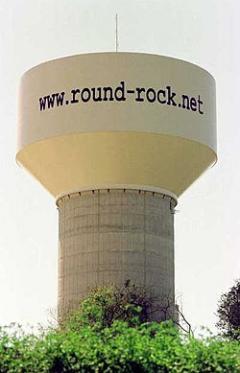
Municipal Utility Districts, commonly called a "MUD", play a significant role in Round Rock. Each is a special-purpose district that provides public utilities such as water, wastewater, storm water, and sometimes roads, parks, solid waste and other infrastructure and services to the residents of that district. MUD's are typically formed by a residential developer as a means to install utilities and roads to a project when a city is not ready or able to provide them. The developer gets reimbursed over time from the fees levied by the MUD, and at some point the area may be annexed by the City to bring the development into the City's tax base once the basic infrastructure costs are paid off. The MUD is represented by its own board of directors who are voted on by the residents of the district, and it has the authority to condemn land, add additional land area, and levy fees in lieu of property taxes to maintain the utilities and other facilities.
There are currently ten MUD's in Round Rock: Brushy Creek, Fern Bluff, Highlands at Mayfield Ranch, Meadows at Chandler Creek, Paloma Lake, Parkside at Mayfield Ranch, Siena, Teravista, Vista Oaks, and Walsh Ranch. Total population living within these MUD's is 47,648 (2010 city estimate).
Round Rock's largest district is Brushy Creek Municipal Utility District. Brushy Creek MUD was formed as Williamson County Municipal Utility District No. 2 in October 1977 with 725 acres (2.9 km2) of land. An annexation in 1983 increased the District to 2,210 acres (8.9 km2). The district name was changed to Brushy Creek Municipal Utility District on August 1990. The MUD provides a wide range of city-like services including parks and recreation, full utilities, road maintennance and a Home Owner's Association. Services a MUD can offer, however are also limited by law (for example they cannot offer library services).
Another similar but somewhat smaller MUD in Round Rock's is Fern Bluff Municipal Utility District in the Wyoming Springs area of town. Both MUD's play a significant role in local governance and maintenance of basic utilities.
From time to time there have been very contentious elections to the boards and heated debates regarding other MUD issues. Round Rock does not often annex a MUD in order to avoiding having to take on the aging infrastructure replacement and upkeep costs.
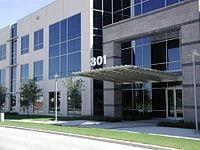
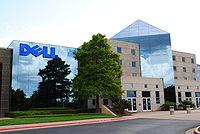
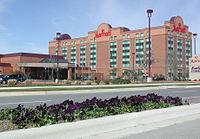
The City of Round Rock has maintained a high quality of life while becoming a major center for economic growth in Central Texas, with industry clusters in clean energy, advanced manufacturing, life sciences and computer/software development.
Round Rock has more than twenty major employers including: Toppan Photomasks, Sears Customer Care, Ikea, Round Rock Premium Outlets, KoMiCo Technology Inc., Texas Guaranteed Student Loan Corp (TGSL), Cintas, Dresser, Hospira, and TECO-Westinghouse, Cerilliant Corporation, Emerson Process Management and Dell.
Dell is a multinational computer and information technology corporation based in Round Rock, which develops, sells and supports computers and related products and services. The company employs about 16,000 people in the Round Rock facilities and about 96,000 people worldwide. Dell was originally based in Austin after its initial formation in 1984 as PC's Limited by UT college student Michael Dell. With the need for significant space as it expanded, the City of Round Rock in 1996 offered Dell a "Chapter 380" agreement by offering to split sales tax revenue from in-state sales 50/50 between Dell and the City. A "Chapter 380" agreement is named for the chapter in Vernon's Statutes that permits sales tax revenue sharing for economic development purposes. It was the first time such an agreement had been used in Central Texas and among the very first in the state. As of 1999, approximately half of the general fund of the City of Round Rock originates from sales taxes generated from the Dell headquarters. Today the company is one of the largest technology companies in the world, listed as number 38 on the Fortune 500 (2010). Fortune also lists Dell as the #5 most admired company in its industry. As part of its clean energy program, in 2008 Dell switched the power sources of the Round Rock headquarters to more environmentally friendly ones, with 60% of the total power coming from TXU Energy wind farms and 40% coming from the Austin Community Landfill gas-to-energy plant operated by Waste Management, Inc.
Round Rock's largest commercial and office business center is La Frontera, located at the intersection of Loop 1, SH 45 and IH-35. La Frontera combines multi-tenant offices, company headquarter facilities, 1,000,000 square feet (90,000 m2) of retail, and several apartment complexes and other smaller retail and housing centers. The project also includes Williamson County's only major hotel, the Austin North Marriot, which provides space for large conferences, meetings and banquets - a first for the county and an important component of Round Rock's economic efforts. The center is also home to the Texas Guaranteed Student Loan Corporation (TGSL). The retail portion is the second largest outdoor commercial project in the Austin - Round Rock Metro area. La Frontera was developed by Bill Smalling and Don Martin, with Fort Worth financier Ed Bass as financial partner.
In 2006, a retail-only hub opened in Round Rock at the corner of Interstate 35 and Highway 1431 (now renamed "University Boulevard"): The major retailer center includes the Simon Property Group's Premium Outlets Mall, across the street is IKEA as well as numerous other retail stores and restaurants. The project was developed by Simon Property Group, with other portions by Barshop & Oles of Austin.
Round Rock has a wide array of hospitals and extensive health care services. Many of these facilities serve not only Round Rock, but the greater Williamson county area, as well as North Austin.
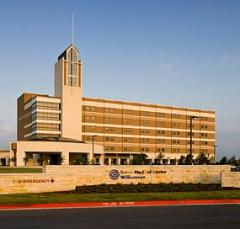
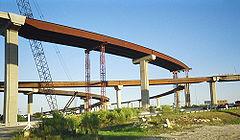
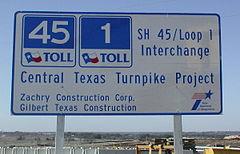
In November 2006, the Central Texas Regional Mobility Authority (CTRMA) opened the first segment of the region's first toll road system. Both State Highway 130 and State Highway 45 toll roads run through portions of Round Rock and provide greatly increased mobility to the city, albeit with strong regional opposition to the high-toll charges to motorists. State Highway 130 runs just south of Austin Bergstrom International Airport at US Highway 183 and connecting to Interstate 35 north of Georgetown, and passes through the easternmost portion of Round Rock. It provides Round Rock residents with quick access to the Austin airport for about $6 each way. The project, when completed, will end at Interstate 10 just east of Seguin, about 30 miles (50 km) east-northeast of San Antonio essentially creating a parallel roadway to Interstate 35.
State Highway 45 is part of an eventual loop that runs east from State Highway 183 in Cedar Park to 130 at Pflugerville (east of Round Rock) where it merges with the SH 130 toll road, and then intercects with the southern portion of SH 45 near Buda, south of Austin. SH 45 passes through the entire southern portion of Round Rock. Highway 45 provides much faster access between Round Rock and Austin, alleviating what was previously a major bottleneck at Interstate 35. The project includes a tolled extension to Loop 1 (also known locally as the "Mopac Expressway") and allows direct access from to I-35 to Loop 1 by use of flyover connections rather than ground level intersections. The toll roads also provide access to the Dell headquarters and its considerable number of employees. Together, both toll roads significantly improve mobility in Round Rock in a positive manner.
Round Rock played a major role in the creation of SH 45 through constant pressure on the Texas Department of Transportation to make it a priority project, the purchase of right of way, and other assistance at critical early stages. Robert L. "Bob" Bennett, who was Round Rock City Manager at the time, oversaw the project for the city. Bennett, now retired, served as a founding member of CTRMA board of directors as an appointee of Williamson County in 2003. Former Williamson County commissioner (and former Round Rock city councilman) Mike Heiligenstein is the Executive Director of the CTRMA.
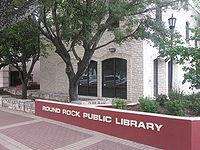
Round Rock Independent School District, a Texas Education Agency Recognized School District, is located in southern Williamson County and northwest Travis County and includes all the City of Round Rock and portions of the City of Austin and the City of Cedar Park. The area covers 110 square miles (280 km2) encompassing high-tech manufacturing and urban retail centers, suburban neighborhoods, and farm and ranch land. "Roughly 45,000 students attend the district's five high schools, ten middle schools, 32 elementary schools, and two alternative learning centers. During the past five years, the number of students has increased by nearly 15%, and enrollment continues to grow by more than 1,200 students per year."
In August 2010 the district opened its fifth high school (Cedar Ridge High School), a ninth grade center reverted to a middle school and the district's 31st elementary school opened in the Stone Oak subdivision. "The average student-teacher ratio for RRISD is 16. The annual dropout rate for students in grades 7 ae 12 is 1.1% and more than 77% of the district's graduating seniors take the SAT and ACT college entrance exams, scoring well above state and national averages." The property tax rates are significantly higher than the national average, and the schools' performance reflects the tax dollars invested.
In the annual report released July 30, 2010 the Round Rock Independent School District received the highest possible rating ("Exemplary") for twenty five of its schools, the highest number so rated in any of the suburban districts in Central Texas. These schools are: Westwood High School. Canyon Vista, Walsh, and Cedar Valley middle schools. Spicewood, Forest North, Caraway, Brushy Creek, Laurel Mountain, Fern Bluff, Canyon Creek, Great Oaks, Teravista, Cactus Ranch, Sommer, Deep Wood, Robertson, Pond Springs, Live Oak, Old Town, Jollyville, Forest Creek, Blackland Prairie, Union Hill and Gattis elementary schools. In 2010 the school district as a whole was rated "academically recognized" a significant step above 2009 when the school district was rated "academically acceptable" by the Texas Education Agency.
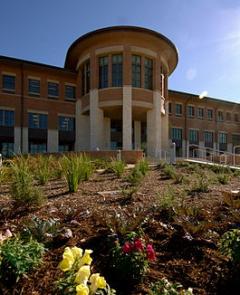
Round Rock also has a number of higher education opportunities. In 1990s, the city, under the leadership of then-City Manager Bob Bennett, planning director Joe Vining, and local citizen Mike Swayze envisioned and oversaw creation of the Texas State University Round Rock Campus (a/k/a Round Rock Higher Education Center - "RRHEC"). The concept was envisioned as a way to lure colleges and universities to jointly provide education, training and degree opportunities on a part-time and full-time bases. The RRC used various empty facilities around town and many of the initial training programs were targeted to help educate students for work at local companies, such as Dell, which had specialized needs. In 2008, an educational campus and the first RRC building aethe Avery Building aewas opened through the combined efforts of Texas State University-San Marcos, Austin Community College, and Temple College in order to provide a broader range of educational opportunities, specialized training, and varying degree programs including post graduate degrees. The campus is in the heart of the emerging Avery Center development which houses Seton Williamson, the A&M Health Science Center and other medical camupuses. By the end of 2009 1,700 students were enrolled in the programs. Texas State University has taken on the lead role in this effort and 100 acres (40 ha) of land for the facility and additional buildings was donated by the Avery family of Round Rock, whose family were early settlers on the land surrounding the RRHEC. Construction on the second Texas State campus building is underway and construction is nearly complete on this additional classroom building. (See also Texas State University Round Rock Campus)
The city is also home to the new Texas A&M Health Science Center Round Rock which opened its doors December 2010. The campus is designed to eventually accommodate as many as 17 additional buildings over time as monies are appropriated each bienniem by the Texas Legislature.
In August 2010 Austin Community College's largest campus in their system, opened adjacent to the Texas State University center. ACC is currently constructing five buildings with a total of 250,000 square feet (23,000 m2) to accommodate up to 5,000 students in its first phase. All three campuses are adjacent to each other within the burgeoning Avery Farms development.
The next component of higher education will be the opening of the St. David's School of Nursing at Texas State University, for which construction is already underway. It will be housed within the University's College of Health Professions. Other programs that are offered by the college are health information management, health services research, and physical therapy.
Round Rock is home to the Class AAA Pacific Coast League minor league baseball team Round Rock Express, owned by RSR Sports (Nolan Ryan, Don Sanders, Reid Ryan) and was founded by Reid Ryan, son of Baseball Hall of Famer Nolan Ryan. As of August 2010 Nolan Ryan is also the new owner of the major league Texas Rangers ball club. Home games for the Round Rock Express are played at the Dell Diamond, a facility that is owned by the City of Round Rock and leased long-term to RSR Sports who run and maintain the facility.
Round Rock opened a free public skate park in 2007 behind the Clay Madsen Recreation Center on Gattis School Road.
Round Rock is the self-proclaimed "Sports Capital of Texas." The City's Old Settlers Park offers a professionally designed disc golf course, cricket, twenty-field baseball complex, five-field softball complex, and seven soccer facilities in addition to the Rockin' River Family Aquatic Center.
The Round Rock independent school district high schools are known for their accomplishments in sports as well, specifically Stony Point high school for being the state semi-finalists 3 years in a row and the second most winning 5A program in the state of Texas.
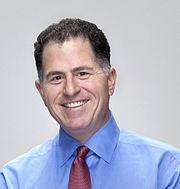
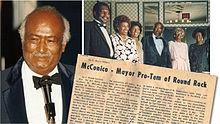
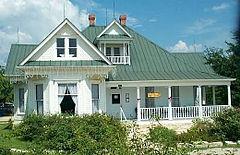

Word Count: 5614






